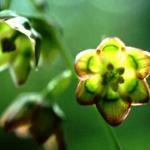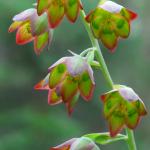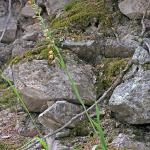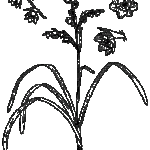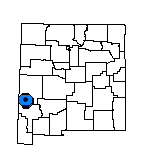Anticlea mogollonensis (Mogollon Death Camas)
ZIGADENUS MOGOLLONENSIS HESS & SIVINSKI
| USFWS | State of NM | USFS | BLM | Navajo Nation | State Rank | Global Rank | R-E-D Code | NMRPTC Status | Strategy Status |
|---|---|---|---|---|---|---|---|---|---|
| SEN | S1 | G1 | 2-1-3 | R | SS |
| Overall Conservation Status | Documented Threats | Actions Needed |
|---|---|---|
| WEAKLY CONSERVED | Fire & fire suppression |
Monitor burned populations, seed banking, survey unburned areas |
Perennial, to 8.5 dm tall from slender ovoid bulbs; basal leaves linear, to 35 cm long; stem leaves fewer and smaller; flowering stem, one per bulb; inflorescence sparsely branched or a single raceme with small leaf-like bracts below each flower that equal or exceed the length of the subtended pedicel; pedicels stout, curved downward when flowering then curved upward in fruit; flowers bell-shaped and nodding; tepals 12-16 mm long, reddish-purple along the margins and blending to yellowish-green at the middle, a greenish-yellow bilobed gland is evident at the interior base of each tepal; ovary partially inferior; capsules erect, 12-15 mm long. Flowers late July to early September.
Anticlea virescens also has nodding flowers but is distinguished by its small white to pale green tepals only 4-8 mm long and shorter bracts (usually less than the length of the pedicel). Anticlea elegans has erect flowering pedicels and broadly spreading flowers (nearly rotate) with white tepals less than 10 mm long.
New Mexico, Catron County, Mogollon Mountains.
Organic soils in understory of upper montane and subalpine coniferous forest, often with aspen; 2,650-3,200 m (8,700-10,500 ft).
A very narrow endemic, known only from the Mogollon Mountains in the area of White Water Baldy and adjacent peaks. Most of its range is within the northwest corner of the Gila Wilderness where it is a common and often abundant forest understory species. Some death camus species are reported to be poisonous, but free-ranging livestock do not intentionally eat them. This is the most beautiful species in the genus and worthy of cultivation.
Most of the known populations and habitat burned in the 2012 Whitewater-Baldy Fire. Plants generally survived the immediate impacts of the fire but long term persistence is questionable in a completely altered habitat (canopy removal)(Roth 2016). Post-fire surveys found the species mostly stable 6 years after the fire, or possibly in decline. Recovery should be closely monitored (Roth 2019).
*Hess, W.J. and R.C. Sivinski. 1995. A new species of Zigadenus from New Mexico, with additional comments on the Section Anticlea. Sida 16(3):389-400.
Zomlefer, W.B. and W.S. Judd. 2002. Resurrection of segregates of the polyphyletic genus Zigadenus s.l. (Liliales: Melanthiaceae) and resulting new combinations. Novon: A Journal for Botanical Nomenclature from the Missouri Botanical Garden 12:299-308.
Roth, D. 2016. Wildfire Impacts on Species of Concern Plants in the Gila National Forest, New Mexico. Unpublished report prepared by EMNRD-Forestry Division, Santa Fe, NM for the U.S. Fish & Wildlife Service, Region 2, Albuquerque, NM. 48 pp.
Roth, D. 2019. Post-fire Status Report Heartleaf Groundsel (Packera cardamine) Mogollon Death Camas (Anticlea mogollonensis). Unpublished report prepared by EMNRD-Forestry Division, Santa Fe, NM for the U.S. Fish & Wildlife Service, Region 2, Albuquerque, NM.
For distribution maps and more information, visit Natural Heritage New Mexico

